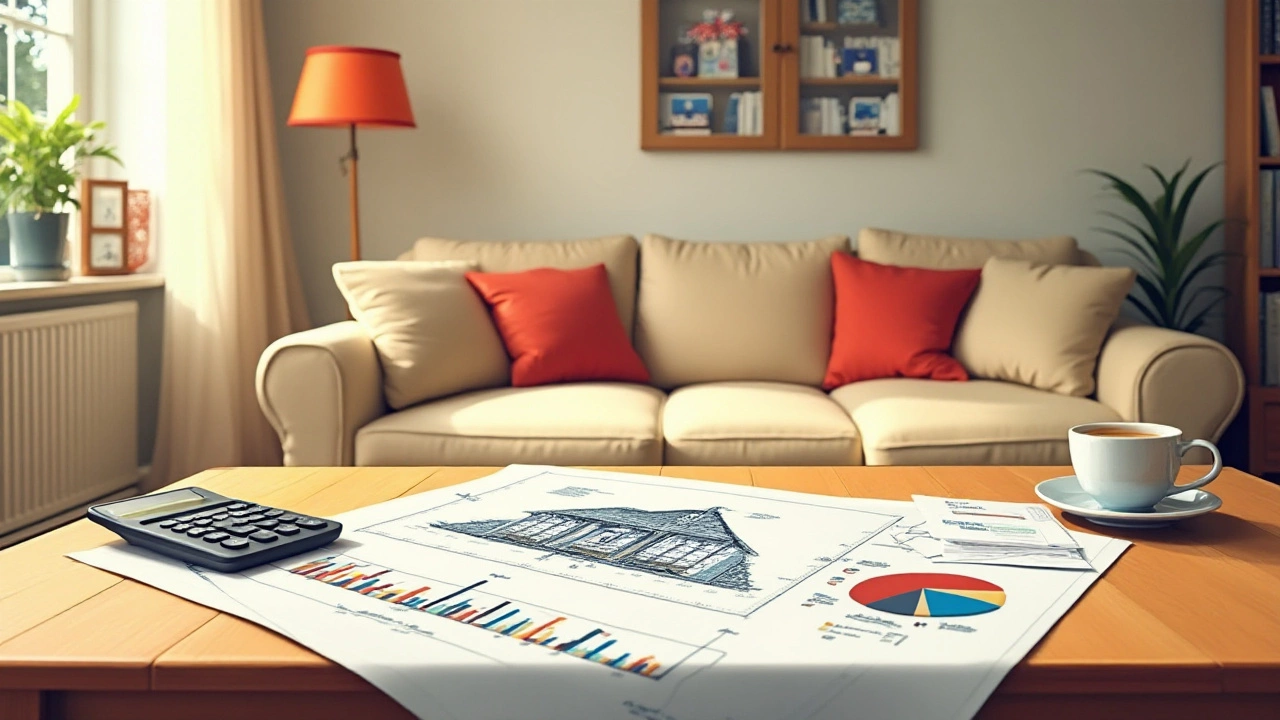So you're at a crossroads, trying to figure out just how much house your $40k salary can bag. It's no small question, and it's one many would-be homeowners are turning over in their minds.
When you're grappling with income limitations, the housing market might seem daunting. But guess what? With a mix of smart budgeting, understanding your mortgage options, and a knack for uncovering the nuances of home buying, you might just find the path to your first home isn't as rough as you thought.
Pulled between dreams of spacious layouts and the reality of your budget, it's all about finding that sweet spot. Let's talk buying power on a shoestring, mortgages that won't sink you, and the overlooked fees that could catch you off guard. Strap in, because this journey begins not with leaping into listings, but knowing exactly where you stand.
- Understanding Affordability
- Budgeting Basics
- Mortgage Options
- Interest Rates and Their Impact
- The Down Payment Dilemma
- Hidden Costs of Homeownership
Understanding Affordability
When you're earning $40,000 a year, understanding what 'affordable' means is crucial for buying your first home. The first step in getting a grip on your affordability is to examine your financial health. This means taking a comprehensive look at your income streams, outstanding debts, and essential monthly expenses. Typically, financial experts suggest keeping your housing costs—mortgage, insurance, and property taxes—within 28% of your gross income. Doing the math, if you earn $40,000 annually, that's roughly $11,200 a year or about $933 a month to spend on housing.
Subtract your monthly obligations from your take-home salary, consider the intricacies of utility bills, and don't forget about groceries or transportation costs. By the time you've deducted all these, you'll get a glimpse of how much you can realistically allocate to your home. It's also important to consider future changes in your life such as potential career advancements or family planning since these affect your long-term affordability. Consulting with a financial advisor before making any decisions could save you more than just headaches down the road.
Interestingly, there's an emotional aspect to home-buying that often gets overlooked. Buying a home isn't just a financial commitment—it's an emotional one too. Expert advice states that you should not feel house poor. That’s when your homeownership costs prevent you from meeting other financial goals, like vacations or dinners out, which brings in a quality of life consideration.
For those wanting numbers at a glance, let’s look at these typical cost allocations for someone with a $40k salary:
| Category | Percentage | Annual Amount |
|---|---|---|
| Housing | 28% | $11,200 |
| Utilities | 10% | $4,000 |
| Groceries | 12% | $4,800 |
| Transportation | 15% | $6,000 |
| Savings & Others | 35% | $14,000 |
Stick to your budget religiously while keeping an eye on options available in the housing market. First-time buyers often find more flexibility through government-backed mortgage programs, like FHA loans, which allow for smaller down payments and have less stringent credit requirements.
Budgeting Basics
Embarking on the journey of buying a home with a $40,000 salary requires a solid understanding of how to stretch each dollar to make your dream of first-time home ownership a reality. It all starts with an accurate assessment of your monthly income and expenses. Every dollar counts, from grocery bills to your morning cappuccino. The general guideline is to keep your monthly housing costs, including mortgage payments, property taxes, and insurance, at or below 28% of your gross income. Thus, on a $40,000 salary, aim to spend no more than $933 a month on these costs.
Breaking it down further, it’s crucial to know where your money goes before you're handed the keys to a new place. Start by listing all income sources and fixed expenses, such as car payments, credit card bills, and student loans. Don’t forget about variable expenses too — groceries, gas, and utilities. Once you have a complete picture, allocate funds for a home savings plan. Think of it as paying yourself first before any discretionary spending happens. Automating your savings can help make this process seamless.
Within your budget, it's wise to account for unexpected expenses. The experts at the Consumer Financial Protection Bureau recommend having an emergency fund that covers three to six months’ worth of living expenses. This advice holds especially true when planning a major purchase like a home. You never know when an unexpected car repair or medical bill might pop up. Also, keeping an eye on your credit score can offer better mortgage rates — a crucial factor when budgeting for affordable housing.
Creating a Savings Plan
Next, constructing a detailed savings plan becomes pivotal. Planning the down payment, which typically ranges from 3% to 20% of the home's purchase price, is one step. Let's break it down. If targeting a $200,000 home (a median range option), you’re looking at needing at least $6,000 for a 3% down payment. This might feel daunting, but break it into manageable monthly goals, and suddenly the impossible becomes possible.
As financial advisor Suze Orman puts it, "Owning a home is a keystone of wealth — both financial affluence and emotional security." Her words encourage the pursuit of a home as a long-term investment that transcends mere shelter.
Finally, take time to engage with free consumer resources that help you understand market trends. These resources can provide data on median home prices and help facilitate a clearer budgeting picture. Websites like Zillow or local real estate listings can serve as practical tools, although consulting a financial advisor is always a smart move to align best practices and personal advice tailored to your case.

Mortgage Options
When you're venturing into the world of homebuying on a first-time homebuyer budget, understanding the different mortgage options available to you is like navigating a maze. But fear not, because we’re here to simplify it for you. First up, the conventional loan. These loans are not backed by the government, which might sound daunting, but they often offer lower interest rates if you have a good credit score. The caveat? They typically require a higher down payment, sometimes around 20%, though with private mortgage insurance (PMI), it can be as low as 3%.
Then there’s the Federal Housing Administration (FHA) loan. This is a popular choice for many, and it's backed by the government, meaning it's designed to be friendly to folks with less-than-perfect credit. What you might experience here are lower down payments, starting around 3.5%, which can ease the burden significantly if you're pinching pennies. Of course, you’ll need to deal with mortgage insurance premiums, which are required for the life of the loan.
According to the Consumer Financial Protection Bureau, "FHA loans have helped first-time homebuyers immensely by lowering the barriers to entry."
Another worthy contender is the USDA loan, specifically for those eyeing rural living. What’s fascinating here is the 0% down payment option, but make sure you qualify based on income and property eligibility, as this program covers a specific demographic. Finally, the VA loan serves veterans and active military members, offering compelling benefits such as no down payment and no mortgage insurance, though funding fees might apply.
To keep things straight in your mind, here's a tip: compare these options side by side. Consider not just the immediate affordability of the monthly payments but also long-term costs and benefits. Dive into the nitty-gritty of interest rates, as they can significantly affect how much you pay back in the end. A few percentage points don't sound like much, but even a small shift can change your financial landscape over 30 years, shedding light on why securing the best rate possible is vital. Calculate what each percentage point translates to in dollars over the term of the loan. It’s enlightening and can often sway which option is truly right for you.
Interest Rates and Their Impact
Interest rates can be the unsung hero or the formidable foe in your home buying journey, especially when clocking in a $40,000 annual salary. They shape not just your monthly mortgage payments but also the total cost of your new home over the lifespan of your loan. With rates fluctuating based on economic conditions, understanding their impact is crucial for any first-time homebuyer. You may be aware that a minor percentage hike can translate into a significant increase in your monthly obligations, potentially stretching your budget beyond comfort. Conversely, a dip in rates could open up possibilities for a larger home or more desirable neighborhood without inflating your costs.
Notably, interest rates are influenced by a combination of federal banking policies, market demand, and even geopolitical events. When the Federal Reserve opts to adjust the rates, it sends ripples across the mortgage sector. Here's a hard fact: for every 0.5% change in interest rates, the affordable home price range for a $40,000 income could sway by thousands of dollars. Imagine a scenario where rates are low; that means more of your payment goes towards the principal balance of the loan, allowing you to build equity faster. It's a bit of a dance, knowing when to lock in a rate and when to pause and wait for a better opportunity, and timing can indeed be everything in this critical decision.
Let's put it into perspective. Suppose your mortgage rate is 4%, and you're looking at a 30-year fixed loan. A $100,000 loan would have you shelling out roughly $477 a month, excluding other costs. Should that rate climb to 5%, the same loan would demand approximately $537 monthly. Over 30 years, even such seemingly minor shifts can stack up to thousands more in interest payments. Consider this: your buying power diminishes as interest rates tick up, reducing the myriad choices you might otherwise have had. It's a balancing act between catching a deal and managing long-term costs, and it calls for strategy and foresight.
"The beauty of interest rates lies not in predicting their moves but in understanding their nature," financial adviser Eli Jacobs once stated. "A shrewd homebuyer knows when to leverage their momentum to their advantage."
When contemplating an affordable housing solution, it's vital to evaluate not just the current rates but also anticipate future movements. From refinancing options to adjustable-rate mortgages, each avenue presents its unique set of advantages and challenges. On a $40k salary, every percentage point matters, making it crucial to explore these options with a clear-eyed focus on both current needs and future goals. Familiarizing yourself with how credit scores impact the rates you're offered is another layer worth attending to. Better scores can unlock lower rates, making them a vital part of your planning strategy.
To empower your home-buying decisions, consider consulting with trusted mortgage advisors or financial consultants to tailor your approach to purchasing a home. Navigating interest rates effectively can save you a substantial amount over time and make your homeowner's dream more attainable. By staying informed about interest rates and understanding their consequences, you pave the way for a more sustainable investment in your new home.
| Interest Rate | Monthly Payment for $100,000 Loan |
|---|---|
| 3.5% | $449 |
| 4.0% | $477 |
| 4.5% | $507 |
| 5.0% | $537 |

The Down Payment Dilemma
Striding confidently into the realm of homeownership, one quickly encounters the elephant in the room: the down payment. For those earning a $40k salary, this can feel like a formidable barrier. Traditionally, the golden rule suggested making a 20% down payment. This is to avoid Private Mortgage Insurance (PMI) and secure better mortgage options. But in an era where saving such a substantial amount poses a Herculean task, many first-time homebuyers opt for lower down payments, compelled by immediate financial realities rather than choice.
Let's put this into perspective. On a $200,000 home, 20% totals $40,000—matching a year's salary for some. Such comparisons are not just eye-opening; they underscore the disparity many potential buyers feel. Today, buyers with tighter budgets have options, such as FHA loans. These require as little as 3.5% down, translating to a much more approachable $7,000. Yet, with lower down payments come the trade-offs: higher monthly payments and mandatory PMI. This is why understanding your financial picture is crucial. It allows for a more precise calculation of not just up-front costs, but long-term feasibility.
It's worth noting that down payment assistance programs have burgeoned, aiming to aid budget-friendly home dreams. From grants to forgivable loans, exploring what's available in your state could lighten your load significantly. Often these programs are designed to support those stepping into the housing market for the first time, especially those constrained by moderate incomes. Some programs target specific geographic areas, profession-based groups such as educators, or environment champions promoting energy-efficient home choices. Such resources often provide the needed boost, bridging the gap between dream and reality.
Moreover, the notion of the down payment extends past mere percentage calculations. Savings strategies play a pivotal role. While reducing day-to-day expenses might seem daunting, every dollar counts. Did you know cutting out a simple daily coffee run could save you nearly $1,500 a year? Imagine redirecting such savings into your 'Home Sweet Home' fund. This is where financial discipline intersects with creative budgeting. Using automatic transfers to a high-yield savings account can bolster your financial position over time. It pays to explore what works best for your situation and stick to a disciplined savings plan.
"Saving for a home is not just about the dollars saved today; it's about building sustainable financial habits for tomorrow," - Greg McBride, Chief Financial Analyst at Bankrate.
Additionally, the financial decisions made in the lead-up to purchasing a home can make or break the process. Streamlining your debt load, optimizing your credit score, and maintaining a stable income all play into how lenders view your risk profile. If your credit score is par excellence, you stand to benefit from not only lower interest rates but potentially better loan terms. Your financial health echoes your preparedness, which can result in lenders being more willing to offer grace with down payment requirements.
The down payment dilemma encapsulates more than just a savings hurdle. It really embodies an intricate balance of planning, financial literacy, strategic compromise, and resource utilization. With first-time homebuyer tools and tips, it's possible to frame this seemingly insurmountable challenge into an achievable milestone, paving the way towards securing your modest yet meaningful first abode in the affordable housing market. As you traverse this path, each step brings you closer to the doorstep of homeownership, turning the impossible into the inevitable.
Hidden Costs of Homeownership
Homeownership often has a charming ring to it—your own piece of the world to call home. But ask anyone who’s taken the plunge, and they’ll probably tell you there’s more to it than just monthly mortgage payments. It’s crucial, especially for first-time homebuyers, to delve into these often overlooked aspects. One of those hidden costs is property taxes, which vary widely depending on the location and assessed value of the home. These taxes are mandatory and don’t shrink with your mortgage balance, so they must be considered in your budget from day one.
Then there’s home insurance, a non-negotiable if you have a mortgage. While it might seem straightforward, insurance can encompass a broad range of protections, from weather-related damage to liability coverages. Prices shift based on the chosen level of coverage, your home’s risk factors, and regional threats. Some buyers may even need additional flood insurance if the property is in a designated flood zone.
"Buying a house is a serious commitment, and understanding the full spectrum of responsibilities and costs is vital," states Jane Hodges, a real estate journalist.
Maintenance is another sneaky cost that resists tidy budgeting. Plumbing leaks, roof repairs, and HVAC breakdowns always seem to happen at the most inconvenient times. An established rule of thumb suggests setting aside 1% of the home’s value each year for repairs and maintenance. However, surprises abound, and costs can soar unexpectedly. For those daring enough to tackle home improvement projects on their own, the initial cost of tools and materials should be part of this tally, paired with the time and skill required.
Homeowners also encounter utility expenses that might come as a shock if upgrading from a smaller space or an apartment. Heating, cooling, water, electricity, and internet bills pile up and fluctuate with seasons and usage habits. Evaluating these costs ahead of the big move helps avoid sticker shock and poor budget adjustments later.
Lawn care, pest control, and HOA fees may also arise, particularly in community developments or condos. These costs can vary dramatically based on the scale and complexity of services required. Some communities mandate that homeowners adhere to specific landscaping standards, which can quickly drive up costs if professional services are needed.
Given the array of hidden expenditures, prospective buyers need a thorough understanding of their financial landscape. An unexpected bill shouldn’t jeopardize their sense of security. By foreseeing the cost of the bells and whistles of homeownership, folks can make informed decisions and stride into their new lives with confidence. It’s not just about securing a mortgage but ensuring that you can afford the lifestyle that comes with buying your first home.
